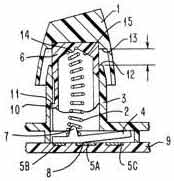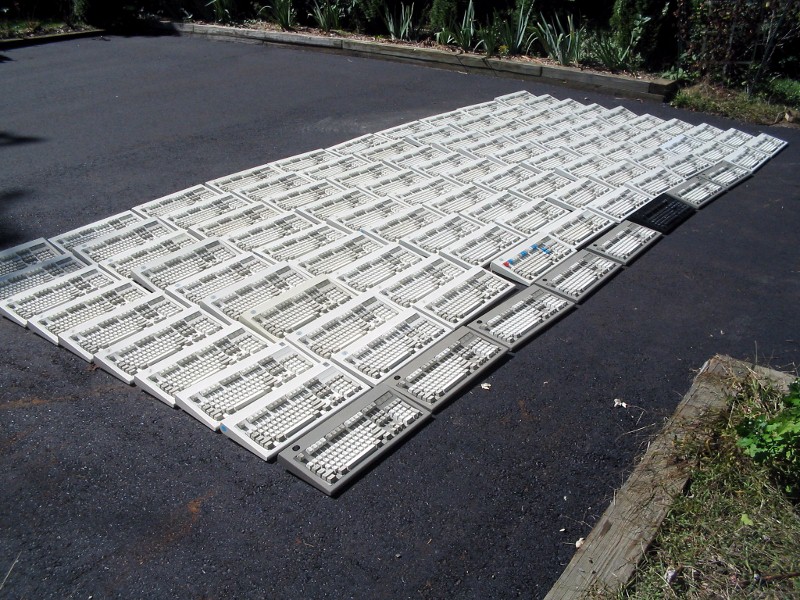 |
"It will be appreciated with regard to the figures that depression of the key button 1 moves the key button and its stem 6 into the housing 3, creating longitudinal compression and lateral deflection of the helical compression spring 2. An initial counter-clockwise moment is exerted on the rocker member 4 which is approximately equal to the force F times the distance between the pivot point 8 of the rocking member 4 and the center line of the spring. The upper end of the helical spring 2 is held squarely against the key button 1 by a clockwise moment created by a force equal to approximately F times the diameter of the spring divided by two. The rocker member 4 will initially be held firmly over the contacts 5A and 5B. As the lateral motion of the center of the helical compression spring 2 increases, both the top and bottom reaction moments in spring 2 are decreased because F is transmitted through the center section of spring 2. Shortly after these moments approach 0, the rocker member rocks to a position squarely over contacts 5A and 5C and the top of spring 2 rocks about the right hand edge of its topmost coil. The constraints upon the depression column spring have changed from an initial end clamped condition to an end clamped-pinned condition. This sudden change provides the tactile response of the key and is accompanied by a sudden rocking action of the rocker member 4 which creates an acoustic feedback as well." source: United States Patent # 4,118,611 Buckling Spring torsional snap actuator. Harris, 1978 |
IBM Model M keyboards
keyboard : a hardware device consisting of a number of mechanical buttons (keys) which the user presses to input text or numerical characters into a computer.
IBM model M keyboard : a hardware device designed and based on IBM mechanical typewriter design, said by some to be the best example of keyboard design, engineering and construction. Each key has an individual micro-switch which uses a buckling spring mechanism to transform human force into an electrical signal.
In 1888, International Business Machines (IBM) was first incorporated. Early on IBM designed and built mechanical "tabulating systems" for accounting and time-keeping. By the 1930’s IBM started to develop and research typewriter technology (IBM model 01 typewriter). Through the 1950s and 1960’s IBM further advanced in their technical expertise in typewriter design (IBM model A, model B, model C typewriters). By 1984, after 50 years of typewriter development, IBM had the expertise and production facilities to develop the first computer keyboard for the IBM Personal Computer (IBM PC). IBM’s design for the 101-key keyboard quickly became the de facto industry standard (IBM model M keyboard),and others imitated and launched the "IBM-compatible" hardware industry.
Today, most computer keyboards are designed and built outside of the United States. Foreign manufacturers try to introduce new tricks and gimmicks to "improve" the computer keyboard (additional "useless" function keys, odd non-standard layouts, LEDs and neon shiny lights, volume dials and controls, clear polymer casings, smaller keys, narrow key spacing, lightweight typing action, use of silk-screened paint to apply lettering to keys or use stickers which wear over time, and basically producing the lowest cost units that need to be replaced on a 2-3 year cycle).
Many computer professionals, prefer to use the one true standard of computer keyboards. Designed by American mechanical engineers, in contrast to new-age designers and focus-group marketing "experts". Many vintage IBM keyboard enthusiasts have purchased one IBM model M keyboard and have been using the same one keyboard for decades.
The computer keyboard is among the most under-appreciated components of the computer. In reality, the keyboard is the one part of the computer that gets the most physical contact. How many times a day do you touch a keyboard (number of characters typed) vs. the number of times you touch your computer’s internals?
As a computer systems engineer in real-life, I typically spend long hours in front of a computer. The last time I checked, I could type as fast as 100 - 110 words per minute. I have always needed an industrial-strength keyboard. In November of 1984, I was able to purchase my first IBM PC 5170 PC/AT (Intel 80286 processor at 8 MHz (.008 GHz) with a 30MB (0.03 GB) hard drive, and 512K (0.5MB) of RAM for $9000. Little did I know that I would still be looking forward to using the same keyboard in 2009 (i.e., TWENTY FIVE (25) years later).
Today’s new entry-level computers (Intel Core 2 Duo, 2.33 GHz, 500GB of hard drive, 4GB of RAM) start at $399. Computer manufacturers bundle these systems with cheap, lightweight "free with purchase" keyboards. As a cost-savings measure (in other words, in order to maximize their profit ) they can not justify anything more than a $5 - $7 keyboard with the belief that most people will not notice the difference. The first thing that I do when I setup a new computer for myself, is re-attach my very durable 1985 IBM model M keyboard (serial #5548).
Keyboards are differentiated by the types of key switches used. Key switches are the part of the keyboard which allows the user to press an individual key and then convert mechanical force into electrical signals. When typing on an mass-produced "rubber dome" keyboard, each key press causes a elastic rubber pad with a carbon center to make contact with conductive points on a plastic sheet. The only feedback that a user receives to verify that a key has been pressed is the visual appearance of the character on the screen.
Buckling spring key-switch keyboards are technically superior because they provide visual , tactile and auditory feedback. Rapid typing occurs as a result of one finger completing a key stroke, while another finger is preparing the subsequent key sequence, and other fingers are preparing to convert the user’s thoughts into action. Each key has an individual weight to it, and experienced typists can apply sufficient, but not extra, force to achieve their goal. (Of course, if the user needs to look down at the keyboard and find each individual key as one types and only uses 2 fingers, that person is a "hunt-and-pecker" typist and types at 10 words per minute (WPM) and probably does not need a technically superior keyboard.)
The most widely produced buckling-spring keyswitch keyboard is the IBM model M keyboard. When pressing an individual key, the operator is physically applying increasing force (approximately 60 - 70 grams of force) against a coiled spring. The spring provides slight resistance, so that you can rest your fingers on the keyboard and not cause an accidental or inadvertent key press. Once the spring travels a particular distance (approx. 2.5 - 3.5mm), the spring reaches the "catastrophic buckling" point and produces an audible click at the same exact instance that the computer records the keystroke.
We have been big fanatics of these keyboards since 1985 and we are happy to help convert and equip as many true computer experts as possible. We have sold these keyboards throughout the United States and to buyers in 40 countries (especially Japan, South Korea, the United Kingdom and Australia)
|
United States Patent # 4,118,611 (click for link to PDF) Title: BUCKLING SPRING TORSIONAL SNAP ACTUATOR |
|
|
|
